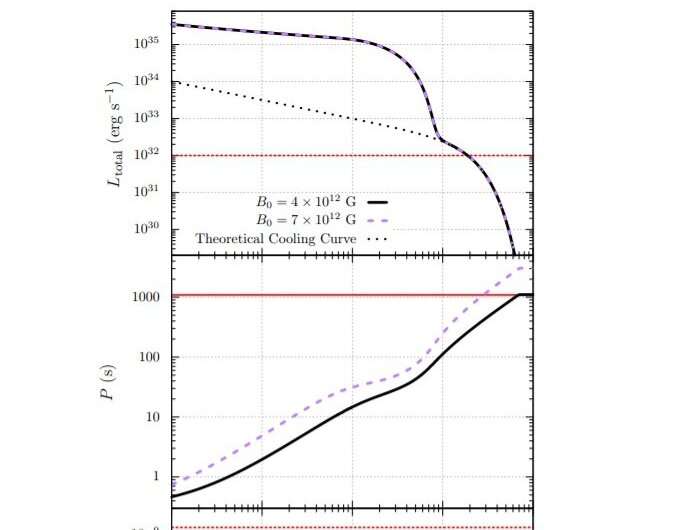February 22, 2022 report
Research investigates evolution of a peculiar slowly-spinning pulsar

Tomasz Nowakowski
astronomy writer

Turkish astronomers have inspected GLEAM-XJ162759.5â523504.3âa recently discovered pulsar with a relatively long spin period. Results of the study, published February 14 on the arXiv pre-print repository, deliver important information regarding the evolution of this peculiar object.
Pulsars are highly magnetized, rotating neutron stars emitting a beam of electromagnetic radiation. They are usually detected in the form of short bursts of radio emission; however, some of them are also observed via optical, X-ray and gamma-ray telescopes.
GLEAM-XJ162759.5â523504.3 has a spin period of approximately 1,091 seconds. It showcases transient radio bursts with durations of about one month, while the pulse widths vary within the range of 30 to 60 seconds. The rotational power of this pulsar was calculated to be less than 12 octillion erg/s, which turns out to be much smaller than the luminosity of the pulsed radio emission that is estimated to be about 40,000 octillion erg/s.
Given that rotational periods of radio pulsars and single neutron stars from other populations usually do not exceed 20 seconds, the long period of GLEAM-XJ162759.5â523504.3 remains a puzzle and challenges present theoretical models. Therefore, a team of astronomers led by Ali Arda Gençali of the SabancÄą University in Istanbul, Turkey, decided to investigate the long-term evolution of this pulsar, hoping to explain its peculiar properties.
"The recent discovery of the very long-period pulsar, GLEAM-XJ162759.5â523504.3, with spin period of 1,091 seconds poses crucial questions for present theoretical models: What is the evolutionary history of this source? Is it a member of an unidentiïŽed new population following an independent evolutionary path, or does it have an evolutionary connection with already known populations?" the researchers wrote in the paper.
Gençali's team found that the properties of GLEAM-XJ162759.5â523504.3 may be a product of long-term evolution in the fallback disk model. They explain that such a long period can be reached by a neutron star evolving with a fallback disk and with a magnetic dipole ïŽeld strength of a few trillion G at the equator.
According to the astronomers, there are two diïŽerent evolutionary scenarios that are compatible with the present properties of GLEAM-XJ162759.5â523504.3. The first one states that the disk is still active and the source is in the accretion with spin-down (ASD) phase at an age of about 300,000 years at present. It means that the period will continue to increase up to a few thousand seconds with a period derivative at a level of 0.1 nanoseconds/second, until the disk becomes inactive at an age of about 700,000 years.
The second scenario suggests that the disk is already inactive and that there is no accretion. In this case, the period has leveled oïŽ at the present value because the dipole torque wields negligible spin-down after disk torques turn oïŽ. It was added that the source should be evolving with a period derivative of about 4 attoseconds/second at the present age greater than 700,000 years.
Written for you by our author âthis article is the result of careful human work. We rely on readers like you to keep independent science journalism alive. If this reporting matters to you, please consider a (especially monthly). You'll get an ad-free account as a thank-you.
More information: Evolution of the long-period pulsar GLEAM-X J162759.5â523504.3, arXiv:2202.06852 [astro-ph.HE]
ÂĐ 2022 Science X Network




















